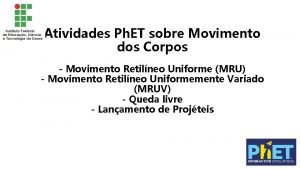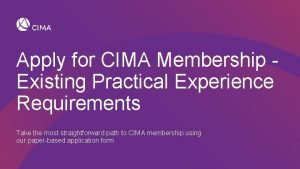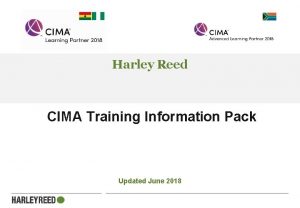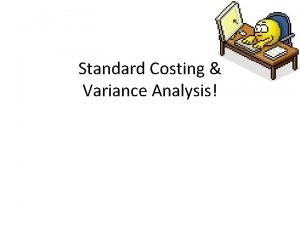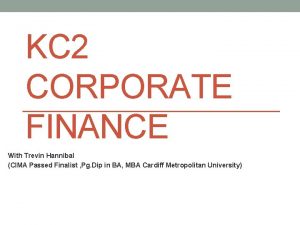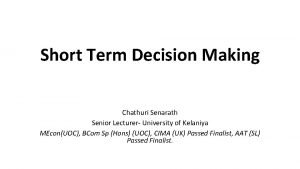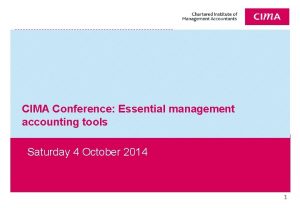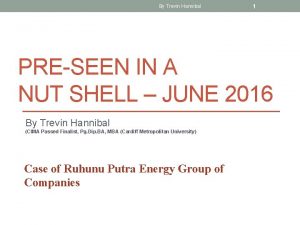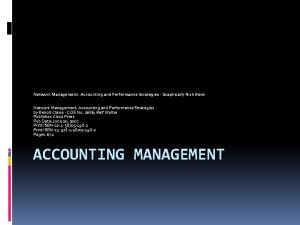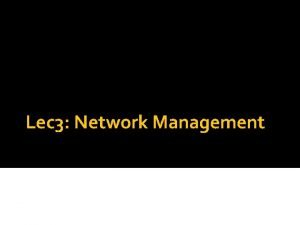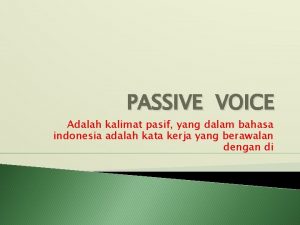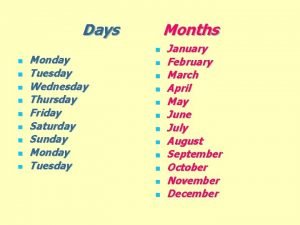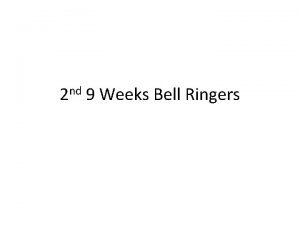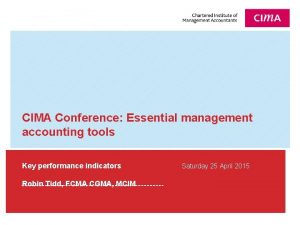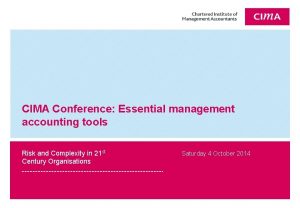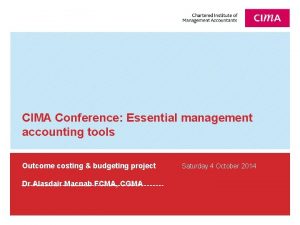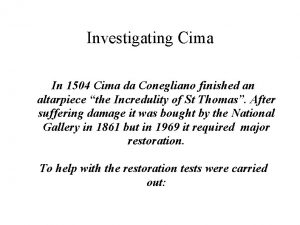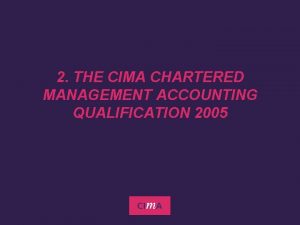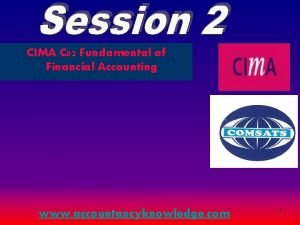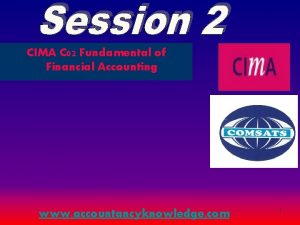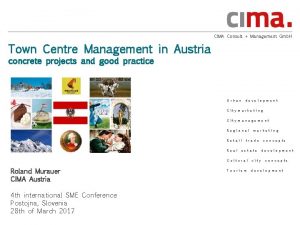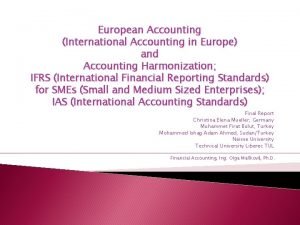CIMA Conference Essential management accounting tools Saturday 4






























































- Slides: 62

CIMA Conference: Essential management accounting tools Saturday 4 October 2014 1

Our Master of Ceremonies Rob Brown 2

AGENDA 09. 50 am MC for the day - Rob Brown. 10. 05 am Opening - Kevin Bragg, Chairman. 10. 20 am Governance and business strategy - Louis Cooper. 11. 15 – 11. 30 am Break 11. 30 am Outcome Costing & Budgeting Project - Dr Alasdair Macnab. 12. 15 pm KPI’s - Robin Tidd 1. 00 – 1. 50 pm Lunch 1. 50 pm Building your reputation - Rob Brown. 2. 50 pm Risk & complexities in the 21 st century – Richard Anderson 3. 30 – 3. 45 pm Break 3. 45 pm Speaker panel questions time. 4. 20 pm Close - R Brown and K Bragg. 3

CIMA Conference: Essential management accounting tools Your CIMA Saturday 4 October 2014 KEVIN BRAGG 4

Why are we holding this conference? How has this all happened? 5

6

7

8

Speakers 9

CPD & Employability This has to be and is a key theme and focus both for Students & Members : • Training Insights and CPD • Thought Leadership • Owning the Management Accounting space 10

11

CIMA Research Reports http: //www. cimaglobal. com/Thought-leadership/ Stay up to speed with new developments by viewing recent CIMA reports online. 12

• CGMA magazine • Online networking • Research papers • Practical tools • Webinars Exclusively yours at www. cgma. org 13

http: //www. cgma. org/Resources/Tools/essential-tools/Pages/list. aspx 14

THANK YOU KEVIN BRAGG CIMA Council Member for EM & EA Kevin. bragg@virtualbusinesspartner. co. uk ©CIMA 15

CIMA Conference: Essential management accounting tools Governance and Business Strategy Saturday 4 October 2014 Louis Cooper 16

Has anything changed? … “… the principal deficiencies in boards related much more to patterns of behaviour than to organisations. The sequence in board discussion on major issues should be: presentation by the executive, a disciplined process of challenge, decision on the policy or strategy to be adopted and then full empowerment… The essential “challenge” step in the sequence appears to have been missed in many board situations and needs to be unequivocally clearly recognised and embedded for the future. . . ” David Walker, UK Banking Review Chairman, November 2009 17

Introductions Louis Cooper Non-Executive Directors Association p: 07899 062125 e: louis. cooper@nedaglobal. com • • • Corporate Governance Risk Management Compliance Assurance Strategy Business Reporting 18

Agenda APPROACH • Your understanding TOPICS 1. Governance • Review of the overall concept 2. Business Strategy • CIMA Essential Tools • Other standards and approaches • Practical examples and case studies 19

1. Governance 20

Governance and YOU… 1. What does it mean? 2. What is all the fuss about? 3. What is YOUR role in Governance? 21

Corporate Governance in action Board of Directors & Committees Legal & Regulatory Monitoring Communication & Trust Enterprise Risk Management Business Practices & Ethics Disclosure & Transparency But what is the missing link? . . . 22

The meaning of corporate governance? “Corporate governance… is the system by which organisations are directed and controlled. It provides a structure through which the organisation’s objectives are set, as well as a basis of attaining those objectives and monitoring performance. ” Key issues: • Compliance vs. Performance focus • Establishing a robust framework • Understanding stakeholder needs 23

Objectives of corporate governance • The objectives of corporate governance should be to ensure that: o the directors act in the best interests of the shareholders (and not in their own self-interest) o the board provides suitable strategic leadership o there is proper accountability of the directors to the shareholders, and a constructive relationship between the directors and shareholders • To achieve these objectives, there must be principles, guidance or rules for companies to follow. 24

The Good… the Bad… and the Ugly… Problems • Most issues seen in large public companies, where the separation of ownership and control is a major problem. • History of corporate failures due largely or entirely to bad corporate governance + Misleading financial reporting • A particular problem has been the domination of companies by an allpowerful CEO/chairman e. g. Maxwell and the Daily Mirror Benefits • Better stakeholder relations • Enhanced reputation • Good communication • Better risk management • Market confidence from positive messages • More investor support when ‘non-compliant’ or when problems arise 25

CIMA: Governance for Performance Corporate governance practice must not lose sight of its underlying purpose – the longterm sustainable success of the organisation. The primary role of the board is to approve, oversee and determine: • short and long-term strategy • an effective business model • risk appetite. Particular areas of focus where organisations and their boards need to focus are: • strategy and risk oversight • boardroom behaviours • the relationship between the board and management. Frameworks and tools include the CIMA Strategic Scorecard®, the board mandate and the COSO Enterprise Risk Management Framework. 26

CIMA Enterprise Governance Framework 27

CIMA Boardroom Leadership Model 28

CIMA: Further reading 29

Governance in the UK and Ireland • Listed companies need to make a statement about: (a) how they have adopted the UK Corporate Governance Code (updated Combined Code) ‘Principles’; and (b) comply with detailed Provisions, giving reasons for noncompliance - “comply or explain” • The Code has been ‘adapted’ for a range of sectors – Private companies, NHS, Charities, Local Govt. • Focus on ‘Guidance and best practice’, although some recent ‘regulation’ under the UK Listing Rules and CA 2006 • Compliance driven by the markets and to date no individual penalties…. . the key driver is flexibility 30

The UK Corporate Governance Code - updated 2010 -12 SECTION PRINCIPLES PROVISIONS A. Leadership [New] A. 1 The role of the Board A. 2 Division of responsibilities A. 3 The Chairman [New] A. 4 Non-Executive Directors [New] 3 1 1 3 B. Effectiveness [New] B. 1 The Composition of the Board B. 2 Appointments to the Board B. 3 Commitment [New] B. 4 Development B. 5 Information and support B. 6 Evaluation B. 7 Re-election 2 4 3 2 2 3 2 C. Accountability C. 1 Corporate Reporting C. 2 Risk Management and Internal Control C. 3 Audit Committee and Auditors 3 2 7 D. Remuneration D. 1 The level and make-up of Remuneration D. 2 Procedure 5 4 E. Communication E. 1 Dialogue with Shareholders E. 2 Constructive Use of AGM 2 4 53 Schedules A. Provisions on the design of performance related remuneration 31

UK Corporate Governance Code 2010 -12 Code Introduction… 32

UK Corporate Governance Code 2014 (updated) Main changes (September 2014) • Going concern, risk management and internal control (C 1 and C 2) o o • Going concern basis of accounting Principal risks - how managed and mitigated Solvency and liquidity risks Disclosures in Strategic Report = ‘safe harbour’ Remuneration (D 1 and D 2) o Policies for long-term success of company o Recovery or withhold variable pay • Shareholder engagement (E 2) • ‘Tone from the Top’ – culture and values • Board diversity 33

Quoted Companies Alliance (‘QCA’) 2013 Code Growth in the long term 1. Vision and strategy 2. Risk management and internal control 3. Corporate communication 4. Needs of shareholders 5. Stakeholders and social responsibilities 6. Cost effective + added value Flexible, efficient and effective framework 7. Developed structures and processes 8. Responsible and accountable 9. Balance on the board 10. Board skills and capabilities 11. Board performance 12. Information and support 34

The Strategic Report Consistency Clarity What worries the board Summarise How money is made Explain change A single story Getting the basics right Cut the clutter Annual Report True and fair 35

Case study examples (1) Corporate PLCs Corporate Private q NEDs and Committees q Exec. Vs. NED q Risk management q Regulators q Big 4 Auditors q Business Advisors q Accounts = ‘War & Peace’ q Vision and IP 36

Case study examples (2) Charity / Nf. P Public Sector q Trustees and Committees q Stakeholders and the board q Risk management q HM Treasury guidance q Internal audit q Framework agreements q The Charity Commission q Annual Governance Statement 37

A Practical Governance Framework Clear direction Internal control and risk management Leadership, strategy and guidance 2 Business objectives 1 Culture, capability and ethics 8 Compliance and investor relations 7 Objective judgement Board procedures and oversight 3 Structures, policies and procedures Stakeholder confidence Annual disclosure Embedded working practices Information flow and reporting routines Assurance and audit provision 4 5 6 Independent review 38

2. Business Strategy 39

Business strategy and YOU… 1. What does it mean? 2. Do you have to have one? 3. What is YOUR role in Strategy? 40

Business Strategy A Definition of Business Strategy ‘Business Strategy’ is a long term plan of action designed to achieve a particular goal or set of goals or objectives. Strategy is management's game plan for strengthening the performance of the enterprise. It states how business should be conducted to achieve the desired goals - without a strategy management has no ‘roadmap’ to guide them. Creating a business strategy is a core management activity. However, having a good strategy and executing the strategy well, does not guarantee success. Organisations can face unforeseen circumstances and adverse conditions through no fault of their own. 41

Deliberate or Emergent? . . . “I dream… I test my dreams against my beliefs… I dare to take risks… and I execute my vision to make those dreams come through. ” The deliberate strategy is analytical and structured - Vision Statement, Mission Statements, Strengths and Weaknesses (SWOT), Objectives etc. On the other hand, the emergent strategy, as the name suggests occurs by chance or happens within the organisation without any long term planning. It occurs from the day to day decisions made to run the company at the tactical and routine level of the company. 42

Strategic Frameworks 43

The Strategy Process Internal analysis External analysis Corporate Appraisal Vision & Mission Strategic Objectives Strategy Implementation 44

Tools of the trade? … SWOT Analysis PESTEL Analysis 45

Stakeholder mapping Low A Minimal Effort B Keep Informed C Keep Satisfied D Key Players Power High Low Level of Interest High 46

Critical success factors CSFs are product features valued by customers where the business will (and must) outperform its rivals. A business must develop Core Competencies which enable it to have satisfy its customers requirements for its CSFs. It should use key performance indicators (KPIs) to measure its core competences 47

The essential ‘toolkit’ I = Innovation M = Marketing R = Resources Q = Quality -------------L = Leadership M = Mentoring S = Selling P = Presenting N = Negotiating F = Finance Str = Strategy setting 48

CIMA Strategic Framework ® Model 49

CIMA: The “Balanced Scorecard” Kaplan and Norton: 1992 50

CIMA: Strategic Mapping Tool 51

CIMA: Porter’s five forces of competitive position 52

Forecasts vs. Uncertainties 53

Strategy and ‘Futures’ 54

Case study example The Strategic Plan q 4 Strategic Groups = 30+ meetings q Mission, Values, Culture Background q City Institution q Commercial vs. Charity q Execs. + NEDs + SMT q SWOT Analysis q Balanced Scorecard and Priorities q Business Planning q Make a difference / game changer? q Committee structure 55

Turning a strategy into action 1. 2. 3. 4. 5. 6. 7. 8. 9. 10. Start with the right frame of mind Think about implementation Involve and communicate Pare down to essentials Spend – invest in resources Keep it simple Measure success Don’t panic… be disciplined Be flexible and adapt Persist and learn from mistakes 56

Conclusion 57

The role of ‘Finance’ is changing EFFICIENCY DATA INFORMATION INFLUENCE REPORTS ANALYSIS INSIGHT INFLUENCE IMPACT 58

Role of the Financial Professional Finance professionals may play different roles in the ‘governance’ supply chain, for example: • Non-executive directors. • CFO – either as an executive member of the board (for example, this is common in the UK) or a member of the executive management team with responsibility for briefing and advising the board. • The role of finance is so crucial to the board’s decision-making that finance professionals throughout the organisation, with responsibility for providing management information to support decision-making, will find themselves supporting the governance process. 59

NEDA: Who we are and what we do ü A Handbook and guide to performing the NED role ü Training and education through courses and seminars (Certificate linked to on-line test) ü Knowledge, news and technical updates ü Insurance cover (D&O) and risk management advice ü Recruitment support for both the individual and company ü Networking opportunities at regular events ü Mentoring and coaching with access to experienced professionals ü Partner organisations…. . 60

THANK YOU Louis Cooper Non-Executive Directors Association p: 07899 062125 e: louis. cooper@nedaglobal. com ©CIMA 61

BREAK Light refreshments served. Please return at 11. 30 am 62
 Management accounting definition by icma
Management accounting definition by icma Cima risk management cycle
Cima risk management cycle Plamatic acid
Plamatic acid Social responsibility accounting ppt
Social responsibility accounting ppt Osu oil and gas accounting conference
Osu oil and gas accounting conference Macizo terrestre
Macizo terrestre Lançamento vertical para cima
Lançamento vertical para cima Quadrantes do abdomen
Quadrantes do abdomen Em uma obra para permitir o transporte de objetos para cima
Em uma obra para permitir o transporte de objetos para cima Movimento vertical
Movimento vertical Qcm cima
Qcm cima Cima per existing requirements example
Cima per existing requirements example Cima gateway route
Cima gateway route Michael cima
Michael cima Subir para cima
Subir para cima La em cima daquela serra
La em cima daquela serra Inflorescencia racemosa
Inflorescencia racemosa Temperatura en las cañadas del teide
Temperatura en las cañadas del teide Seringa
Seringa Material price variance
Material price variance Trevin hannibal
Trevin hannibal God the father painting by cima da conegliano
God the father painting by cima da conegliano Short term decision
Short term decision Cima sgh
Cima sgh Cima code of ethics 5 principles
Cima code of ethics 5 principles Balanced scorecard cima
Balanced scorecard cima Trevin hannibal
Trevin hannibal Accounting management in network management
Accounting management in network management Managing entity network management
Managing entity network management Accounting management in network management
Accounting management in network management Sewing tools measuring tools
Sewing tools measuring tools What do you usually do on saturdays
What do you usually do on saturdays What does he do on saturday
What does he do on saturday I'm thinking of ____________ a party on saturday.
I'm thinking of ____________ a party on saturday. What you last weekend?
What you last weekend? We ...... a big piece of wood last saturday. (see)
We ...... a big piece of wood last saturday. (see) So what did you do last saturday
So what did you do last saturday Saturday morning prayer images
Saturday morning prayer images Evening prayer
Evening prayer Prayer for black saturday
Prayer for black saturday Easter triduum meaning
Easter triduum meaning Weekend activities
Weekend activities Saturday morning prayer
Saturday morning prayer Saturday morning prayer images
Saturday morning prayer images Saturday night prayer
Saturday night prayer On saturday rima's father gives her a seed
On saturday rima's father gives her a seed Strong alliteration
Strong alliteration Green symbolizes hope
Green symbolizes hope Sunday spiritual blessings
Sunday spiritual blessings Jerome 6 and hani 10 get up early on saturday morning
Jerome 6 and hani 10 get up early on saturday morning Saturday before easter
Saturday before easter My favourite day is saturday
My favourite day is saturday On saturday he ate through one piece of chocolate cake
On saturday he ate through one piece of chocolate cake Saturday climbing frizzy haired girl
Saturday climbing frizzy haired girl The fire destroyed the house yesterday
The fire destroyed the house yesterday Monday tuesday is my weekend
Monday tuesday is my weekend Monday tuesday wednesday thursday friday saturday sunday
Monday tuesday wednesday thursday friday saturday sunday Tuesday morning prayer
Tuesday morning prayer Saturday morning prayer
Saturday morning prayer Saturday question
Saturday question I set the table at the andersons house on saturday
I set the table at the andersons house on saturday Saturday in hangul
Saturday in hangul Saturday morning prayer
Saturday morning prayer









